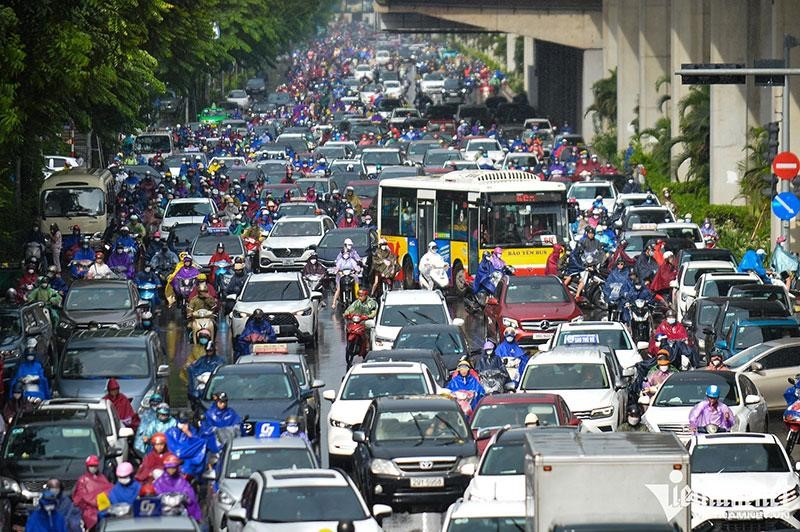I. Road Traffic Planning in Hanoi
a. Introduction
The road traffic system in Hanoi plays a vital and indispensable role in the comprehensive development of the city, especially in the context of an increasingly innovative and developing economic and social environment. This is considered a significant driving force behind the dynamism and vibrancy of the urban economy, where the road traffic system is not only a connector between districts but also a crucial factor determining the linkage between regions, industries, and service sectors.
- Road Traffic Planning in Hanoi
Road traffic planning in Hanoi is carried out based on the city’s general planning, including urban development planning, transportation planning, and socio-economic development planning. The goal is to build an efficient, safe, and sustainable road traffic system that meets the mobility needs of the population and supports socio-economic development.
Hanoi will develop a road network with main traffic arteries, highways, bridges, and tunnels to connect areas within the city and nearby regions. At the same time, measures will be implemented to reduce traffic congestion and improve traffic safety, including the construction of secondary routes, ring roads, and city access roads.
b. Planning Objectives
- Develop a complete transportation system that meets the criteria of sustainability, integration, and modernity based on the orientation of the General Construction Planning of Hanoi Capital to 2030 and vision to 2050.
- Specify the orientation of Hanoi Capital’s Transportation Planning within the General Construction Planning of Hanoi Capital to 2030 and vision to 2050.
- Develop investment plans for the transportation system in phases, identifying priority projects.
- Propose solutions for traffic organization, management, and policy mechanisms for planning implementation and management.
- Serve as a basis for the development of transportation infrastructure investment projects in Hanoi.
II.Current state of Road Traffic in Hanoi
Hanoi’s current road traffic network in operation has a total length of 23,420.2 km, including 5 highways and ring roads; 11 national roads; 128 provincial roads; 1,220 urban roads… Hanoi has 7 ring roads (5 urban rings; 2 regional rings); 9 highways; 11 radial axes; 18 bridges crossing the Red River, 8 bridges crossing the Duong River; 20 main urban axes (11 in the North of the Red River; 9 in the South of the Red River); 08 secondary urban axes.
According to statistics from the Hanoi Department of Transport, as of November 2022, Hanoi has 7,784,657 vehicles (1,056,423 cars, 6,545,317 motorcycles, 182,917 electric motorcycles), not including about 1.2 million vehicles from other provinces participating in Hanoi’s traffic. Meanwhile, the public passenger transport network by bus includes 154 routes, reaching all 30 districts, towns, and cities, achieving 100% accessibility, with the current public transport ridership rate at about 17.8%.
According to the approved Transportation Development Plan of Hanoi to 2030 with a vision to 2050, the land area allocated for transportation must reach 20-26%; the area for static traffic is 3-4%, and the public transport ridership rate must reach 50-55%. However, the current land area allocated for transportation in the urban construction area is about 10.07%; the area for static traffic is less than 1%; the public transport ridership rate is about 17.8%.
III. Development Plan for the Road Traffic System in Hanoi
-
Objectives
According to plan number 195/KD(2), Hanoi’s People’s Committee aims to increase the ratio of land allocated for transportation compared to urban construction land from 0.25-0.3% (the total land area allocated for transportation in 2023 will reach 10.65% of urban construction land). Strive to reduce traffic accidents by 5% to 10% annually across all three criteria (number of incidents, number of deaths, number of injuries), and aim to prevent any particularly severe traffic accidents. Ensure the quality of public passenger transport, aiming to achieve the target public transport ridership rate in 2023 of 21.5-23%.
REFERENCES
- Plan 195/KH-UBND Hanoi 2023 Addressing limitations and shortcomings related to “inconsistent transportation infrastructure; traffic congestion still occurs in some places” (25/7/2023)
- Decision No. 519/QDD-TT by the Prime Minister: Approving the Transportation Planning of Hanoi Capital to 2030, vision to 2050 (31/3/2016).
- Ministry of Natural Resources and Environment of Vietnam, 2019. Air Quality Assessment Report in Hanoi
- Đang Son; Planning for Hanoi’s urban railway network: Addressing inconsistencies promptly; 20/8/2023; Economic and Urban Newspaper.
See our full report here: https://docs.google.com/document/d/19ruB3dA4HgEs0EnQu0ArOUFwzhGC53V6/edit



 Tiếng Việt
Tiếng Việt 日本語
日本語